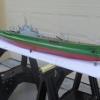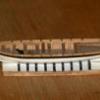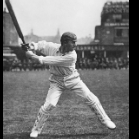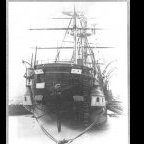Supplies of the Ship Modeler's Handbook are running out. Get your copy NOW before they are gone! Click on photo to order.
×
-
Posts
3,462 -
Joined
-
Last visited
Reputation Activity
-
 amateur got a reaction from pirozzi in New here. Possibly in over my head.
amateur got a reaction from pirozzi in New here. Possibly in over my head.
Don't panic: it is like a lego box, but a slightly more complicated one
Buying second hand is a bit of a risk: the box already being opened can result in either missing, or damaged parts.
Buying a kit that is already started, is also a risk: you start out with the problems an other person made.
Having siad that:
step 1: check the contents of the box (check it against the instruction booklet, which I hope is there, otherwise you have a BIG chalenge)
step 2: read the instruction booklet (not hust the first step, but all of it, at least twice). You can also do this as step 0
Step 3: try to imagine where everything has to go (more or less)
step 4 buy you some basic tools and materials.
a small hammer, couple of pins (you know the long shapr ones, the missus uses when creating a new dress). Clothing peggs can be usefull as well as clamps. Buy something like a couple of sharp knives (the X-acto will do, don't forget the spare blades, as you will snap and damage a couple when going along).
for glue: white wood glue, gives you plenty of grip, and plenty of correction time.
Some modellersfiles (not the heavy metal workers version), and sandpaper (course and fine).
Accept the fact that you will come to the point that your tools don't suffice, and buy when needed. No need to set up a full scale modellers workshop before starting your first.
Don't set your standards too high. I don't know what you paid for this kit, but be prepared to think "ah well, it was only just for fun, and I had some fun trying". The 'next will be better thought' will never leave you, however high quality you will ever reach
With respect to the model itself: it looks as if the frames are already glued to the keel. If so, make sure that the keel is straight, and than the frames are perpendicular to the keel.
And then you are off, onto a whole new road: read the booklet, and sees what comes next.
Remeber: it is very tempting to do things not in the order the booklet shows, but they are there (probably) for a reason. In all cases: don't forget to think ahead. What comes next, and how am I going to do it.
In case of doubt or emergency: stop working, and give us a shout and a picture.
Jan
-
 amateur got a reaction from Canute in V108 Torpedo Boat by glennreader - Digital Navy - 1/200 - CARD
amateur got a reaction from Canute in V108 Torpedo Boat by glennreader - Digital Navy - 1/200 - CARD
Angling that part can be disrupting..... I should have done the same:cutting and glueing.
I didn’t dare to do the steps
jan
-
 amateur got a reaction from Piet in SMS Seydlitz by Canute, Cog, Stein Gildberg & RGL - FINISHED - Hobbyboss - 1/350 - PLASTIC
amateur got a reaction from Piet in SMS Seydlitz by Canute, Cog, Stein Gildberg & RGL - FINISHED - Hobbyboss - 1/350 - PLASTIC
Looking wonderfull.
the booms are around 10 milimeters?
Jan
-
 amateur got a reaction from popeye the sailor in SMS Seydlitz by Canute, Cog, Stein Gildberg & RGL - FINISHED - Hobbyboss - 1/350 - PLASTIC
amateur got a reaction from popeye the sailor in SMS Seydlitz by Canute, Cog, Stein Gildberg & RGL - FINISHED - Hobbyboss - 1/350 - PLASTIC
Looking wonderfull.
the booms are around 10 milimeters?
Jan
-
 amateur reacted to Javier Baron in Fécamp herring lugger by Javier Baron - FINISHED - Scale 1:200 - Lougre harenguier
amateur reacted to Javier Baron in Fécamp herring lugger by Javier Baron - FINISHED - Scale 1:200 - Lougre harenguier
I start a new model for my collection. It is a "Lougre harenguier" by Fécamp, based on the plans in the collection "Souvenirs de Marine Conservés" by Admiral Paris and the monograph of the "Bois-Rosé" of the Association of Friends of the Navy Museum from Paris. The system that I follow for the construction of the hull is that of disposable frames. This system of disposable frames I already showed it in my previous Build Log of the Tartana de Liguria.
I believe that the photographs clearly show what the process that I carry out. I started this model about ten days ago, and the last pictures show the current status of the work in progress.
-
 amateur got a reaction from mtaylor in SMS Seydlitz by Canute, Cog, Stein Gildberg & RGL - FINISHED - Hobbyboss - 1/350 - PLASTIC
amateur got a reaction from mtaylor in SMS Seydlitz by Canute, Cog, Stein Gildberg & RGL - FINISHED - Hobbyboss - 1/350 - PLASTIC
Looking wonderfull.
the booms are around 10 milimeters?
Jan
-
 amateur got a reaction from Old Collingwood in Friesland 1663 by zappto - FINISHED - Mamoli - 1:75 - Dutch 80 gun ship
amateur got a reaction from Old Collingwood in Friesland 1663 by zappto - FINISHED - Mamoli - 1:75 - Dutch 80 gun ship
Placing your model in the snow. I wouldn't dare.....
Your rigging looks great!
Jan
-
 amateur reacted to Bob Cleek in Admiralty model query
amateur reacted to Bob Cleek in Admiralty model query
HI Jan,
You're quite right that there are a lot of corners that can be cut. Particularly when working at small scales the degree of latitude being inversely proportional to how anal the modeler may be, but don't forget that somebody had to draw the lines somewhere along the way and there's no way to turn those lines into a three dimensional boat without some sort of "lofting," even if done mechanically, rather than on paper. For example, the architects who designed vessels using half-hull models, such as Nathaniel Herreshoff, often devised mechanisms to mechanically generate their offsets directly from their half-models without ever drawing plans at all. The loftsmen then lofted their patterns working from a table of offsets measured off the half-model itself without any intermediate drawings at all. You'll find very few drawings of Herreshoff's famous works in the MIT library. The "plans" of his vessels in their much-studied "Herreshoff Collection" exist mainly as tables of offsets in his handwritten notebooks. The discussion at hand arose from a good question: "How do you get the patterns for frames," or more broadly, the construction patterns, "from a lines drawing" or from a table of offsets? The answer is that you have to loft the vessel, which led to a discussion of naval architectural drafting. The entire context of the discussion really exists in the realm of scratch-building models of vessels for which there are not construction plans available which are suitably drawn for modeling purposes. That does, of course, "make things more difficult," as you note. It's a challenge that I expect anyone wishing to build an accurate model of a vessel nobody has modeled before, or at least for which "modeling" plans aren't available, or unavailable in the scale they wish, is going to have to accept.
That said, fairing the frame bevels on the set up frames is often the easiest way to go on a model, but, as the original poster here realized, one still has to get the molded shape of the frames from somewhere. I'm well-acquainted with how Lloyd McCaffery accomplishes that by "mechanically lofting" frames with his shaping-a-block-made-of-a-sandwich-of-frame-blanks method, but I submit that is a far more practical approach with the miniatures he built than with larger scales. I've had the pleasure of studying some of his models on display in the Columbia River Maritime Museum in Astoria, OR, and they are truly amazing, but however accurate they may be, their diminutive size limits their usefulness as future objects for historical study. He is more than a modeler. He's a "miniaturist." His work is in the same class as the proverbial "The Lord's Prayer" engraved on a grain of rice exhibited beneath a microscope!
Like some, my model building is more sporadic than I'd wish. I keep getting sidetracked restoring other people's models. With retirement on the horizon, and the physical limitations of age curtailing the work on full-size wooden boats I used to do more frequently, I'm gearing up to proceed with a number of original modeling projects I've "had on the back burner." Relative to your observation, I've been researching the Irish Hooker type the last few years for the purpose of building a model which accurately portrays certain of their characteristic construction techniques. Hookers were never built to plans, but rather to "rules of thumb" based upon the size of the boat and handed down orally. (e.g.: "the mast is as long as the length of the boat on deck.") One distinguishing feature of hookers is that their frames are built of sawn floors and futtocks which are lapped alternately with the laps fastened in a particular way. In building, the shape of the boat is defined by three molds, one midships, one forward and one aft of midships, and a transom. The mold patterns were proprietary to the builders and their descendants. Battens were set up on the molds and the floors and futtocks were shaped to fit to the inside of the battens. There are only about four accurate sets of plans that have been taken off existing hookers and, given the way the floors and frames are fashioned, trying to develop the floor and futtock shapes on paper would be a nightmare. I've concluded that the easiest way to go is to build the model the same way the original was built. In that case, yes... the lofting will be minimal, but the fitting will be a challenge.
"My name is Bob and I'm a tool-aholic." I consider some tools objects of beauty whether I really need them or not. Others can accomplish as much and often more as I can with far fewer tools. I certainly do hope that the discussion of the rather arcane craft of naval architectural drafting and lofting didn't scare anybody off! If one side of a model isn't shaped exactly the same as the other, one could even argue that in that respect the model might be a more accurate representation of a lot of full-sized wooden ships and boats!
-
 amateur got a reaction from Trumper07 in Admiralty model query
amateur got a reaction from Trumper07 in Admiralty model query
Hi Bob,
Although I admire your knowledge and your equipment (guess you also use it for models, bur couldn’t find anything of that work here at msw), I wonder whether you make things more difficult than necessary: you can draw ideal lines, but I guess (never tried myself) that slightly less ideal would also work. The final fairing is done when frames are set up in the model so the use of a simple pencil and ruler and a basic set of curves should do for a beginner.
I have even seen an admiralty type of model without lofting, using just station lines. Also Mccaffery uses such a method for his small-scale models: he cleverly builds up a layered block, and shapes it as if it were a solid hull modell. Requires some thinking and preparation, but it works without any curves or dawing let alone drafting.
Jan
-
 amateur got a reaction from mtaylor in Admiralty model query
amateur got a reaction from mtaylor in Admiralty model query
Hi Bob,
Although I admire your knowledge and your equipment (guess you also use it for models, bur couldn’t find anything of that work here at msw), I wonder whether you make things more difficult than necessary: you can draw ideal lines, but I guess (never tried myself) that slightly less ideal would also work. The final fairing is done when frames are set up in the model so the use of a simple pencil and ruler and a basic set of curves should do for a beginner.
I have even seen an admiralty type of model without lofting, using just station lines. Also Mccaffery uses such a method for his small-scale models: he cleverly builds up a layered block, and shapes it as if it were a solid hull modell. Requires some thinking and preparation, but it works without any curves or dawing let alone drafting.
Jan
-
 amateur got a reaction from paulsutcliffe in Admiralty model query
amateur got a reaction from paulsutcliffe in Admiralty model query
Hi Bob,
Although I admire your knowledge and your equipment (guess you also use it for models, bur couldn’t find anything of that work here at msw), I wonder whether you make things more difficult than necessary: you can draw ideal lines, but I guess (never tried myself) that slightly less ideal would also work. The final fairing is done when frames are set up in the model so the use of a simple pencil and ruler and a basic set of curves should do for a beginner.
I have even seen an admiralty type of model without lofting, using just station lines. Also Mccaffery uses such a method for his small-scale models: he cleverly builds up a layered block, and shapes it as if it were a solid hull modell. Requires some thinking and preparation, but it works without any curves or dawing let alone drafting.
Jan
-
 amateur got a reaction from Rik Thistle in Varyag 1901 by Valeriy V - FINISHED - scale 1:75 - Russian Cruiser
amateur got a reaction from Rik Thistle in Varyag 1901 by Valeriy V - FINISHED - scale 1:75 - Russian Cruiser
That is quite impressive!
Jan
-
 amateur got a reaction from Bob Cleek in Admiralty model query
amateur got a reaction from Bob Cleek in Admiralty model query
Hi Bob,
Although I admire your knowledge and your equipment (guess you also use it for models, bur couldn’t find anything of that work here at msw), I wonder whether you make things more difficult than necessary: you can draw ideal lines, but I guess (never tried myself) that slightly less ideal would also work. The final fairing is done when frames are set up in the model so the use of a simple pencil and ruler and a basic set of curves should do for a beginner.
I have even seen an admiralty type of model without lofting, using just station lines. Also Mccaffery uses such a method for his small-scale models: he cleverly builds up a layered block, and shapes it as if it were a solid hull modell. Requires some thinking and preparation, but it works without any curves or dawing let alone drafting.
Jan
-
 amateur got a reaction from mtaylor in King of the Mississippi by Anna - Artesania Latina - 1:80
amateur got a reaction from mtaylor in King of the Mississippi by Anna - Artesania Latina - 1:80
Problem with electrical tools: sometimes they tend to take too much in too short a period.
just doing it by hand takes more time, but I find control a bit easier.
Jan
-
 amateur got a reaction from Old Collingwood in King of the Mississippi by Anna - Artesania Latina - 1:80
amateur got a reaction from Old Collingwood in King of the Mississippi by Anna - Artesania Latina - 1:80
Problem with electrical tools: sometimes they tend to take too much in too short a period.
just doing it by hand takes more time, but I find control a bit easier.
Jan
-
 amateur got a reaction from Jack12477 in SPERWER by KORTES - FINISHED - 1:30 scale - Friescheboeier Yacht
amateur got a reaction from Jack12477 in SPERWER by KORTES - FINISHED - 1:30 scale - Friescheboeier Yacht
HiVossie,
it is even weirder: the botteloef is not a bowsprit in a normal way. Therefore, next to this botteloef (and its extension 'opsteker'), these ships often had a separate boom as bowsprit.
the botteloef is intended to have the fore sail forward as much as possible, as that improves sailing qualities. (And that is also the reason that some owners had the botteloef extended using such an opsteker: getting the fore sail even further forward. )
Jan
-
 amateur got a reaction from popeye the sailor in King of the Mississippi by Anna - Artesania Latina - 1:80
amateur got a reaction from popeye the sailor in King of the Mississippi by Anna - Artesania Latina - 1:80
Problem with electrical tools: sometimes they tend to take too much in too short a period.
just doing it by hand takes more time, but I find control a bit easier.
Jan
-
 amateur got a reaction from Keith Black in SPERWER by KORTES - FINISHED - 1:30 scale - Friescheboeier Yacht
amateur got a reaction from Keith Black in SPERWER by KORTES - FINISHED - 1:30 scale - Friescheboeier Yacht
Beautiful rudder!
question: you are not using black paint, but black wood instead.
How are you going to apply the distinctive white striping?
Jan
-
 amateur got a reaction from Keith Black in SPERWER by KORTES - FINISHED - 1:30 scale - Friescheboeier Yacht
amateur got a reaction from Keith Black in SPERWER by KORTES - FINISHED - 1:30 scale - Friescheboeier Yacht
Btw make sure the bolt is in the correct place: it is slightly below the centerline of the leenord, not on the centerline.
this image shows a drawing of a portside leeboard of a friese boeier (drawing downloaded from maritiem digitaal), newer than Sperwer, but valud for almost all boeiers, i guess)
Jan
-
 amateur got a reaction from Doreltomin in SPERWER by KORTES - FINISHED - 1:30 scale - Friescheboeier Yacht
amateur got a reaction from Doreltomin in SPERWER by KORTES - FINISHED - 1:30 scale - Friescheboeier Yacht
But a square hull would never do
Although: most working ships tend to be rather box-like: the main frame of a tjalk, fluit or aak, all tend to be rather square.
and it is a mis-conception that dutch calvinists did not like beautifull (and expensive) stuff. Quite a lot of expensive houses around.....
jan
-
 amateur got a reaction from Keith Black in SPERWER by KORTES - FINISHED - 1:30 scale - Friescheboeier Yacht
amateur got a reaction from Keith Black in SPERWER by KORTES - FINISHED - 1:30 scale - Friescheboeier Yacht
Very nicely indeed
Jan
-
 amateur got a reaction from Keith Black in SPERWER by KORTES - FINISHED - 1:30 scale - Friescheboeier Yacht
amateur got a reaction from Keith Black in SPERWER by KORTES - FINISHED - 1:30 scale - Friescheboeier Yacht
Clever!
jan
-
 amateur got a reaction from Keith Black in SPERWER by KORTES - FINISHED - 1:30 scale - Friescheboeier Yacht
amateur got a reaction from Keith Black in SPERWER by KORTES - FINISHED - 1:30 scale - Friescheboeier Yacht
Hi Kortes,
I guess you have seen the original bars on Sperwer?
that pattern is very distinctive, more than the rather basic pattern you have used.
Did you simplify on purpose?
jan
-
 amateur got a reaction from Keith Black in SPERWER by KORTES - FINISHED - 1:30 scale - Friescheboeier Yacht
amateur got a reaction from Keith Black in SPERWER by KORTES - FINISHED - 1:30 scale - Friescheboeier Yacht
HiVossie,
it is even weirder: the botteloef is not a bowsprit in a normal way. Therefore, next to this botteloef (and its extension 'opsteker'), these ships often had a separate boom as bowsprit.
the botteloef is intended to have the fore sail forward as much as possible, as that improves sailing qualities. (And that is also the reason that some owners had the botteloef extended using such an opsteker: getting the fore sail even further forward. )
Jan
-
 amateur got a reaction from Keith Black in SPERWER by KORTES - FINISHED - 1:30 scale - Friescheboeier Yacht
amateur got a reaction from Keith Black in SPERWER by KORTES - FINISHED - 1:30 scale - Friescheboeier Yacht
Hi Kortes,
nicely done.
your decision to make a stained glass appearance is good: these ships showed the standing of its owner. Just plain glass would not do
The other part is called mastkoker. (Not mast in mastkoker). A heavy piece. Attached to the ships bottom, as it is the connection between hull and mast.
Jan












